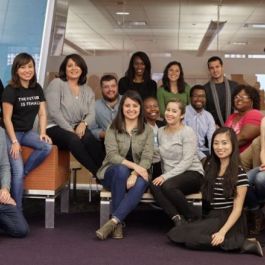Interviewing can be tough under normal circumstances, for candidates and hiring managers alike. But doing it virtually — without the proper tools or processes — can make the experience as cumbersome as inefficient code.
Many engineering teams had to switch to virtual interviewing when the coronavirus switched much of the professional world to remote work. Leaders needed to determine how to keep their candidate experiences pleasant and ensure they could still assess the skills they were seeking. For teams in New York, this shift required adaptability and a reliance on tools both old and new.
Zoom — a platform common in many companies before COVID-19 — was leaned on more heavily to replace in-person handshakes and greetings, while platforms like CodeSandbox, CoderPad and even Google Docs were tested, evaluated and adopted to replace whiteboards and perform code tests. For whiteboard sessions specifically, some leaders found their new tools to be even more effective than the in-person practice because candidates felt less pressure.
Engineering interviews now look different at many New York companies, and there are a number of techniques these teams adopted to take their candidate discussions online.
Best practices for digital dev interviews:
- Test every step of scheduling and facilitating a digital interview to ensure maximum efficiency.
- Be transparent about the tech tools used in interviews so candidates can familiarize themselves beforehand.
- Discuss with the interview team who will be assessing for which skills. Prevent multiple people from asking the same questions.
- Collaborate during a coding exercise by highlighting specific lines of code for the candidate.
- Have a team member or tool keep track of time.
With the adoption of new tech tools comes a need to learn best practices for using them. Mario Pabon, tech lead at real estate tech company Ribbon, said engineering leaders should avoid complex and clunky interview tools that could make the experience more cumbersome for everyone.
What tools do you use to conduct code review and whiteboarding interviews virtually?
All of the tools we use for virtual interviewing are one-to-one replacements for tools that we’d use in person. We have Zoom in place of in-person interaction, CodeSandbox to replace an interview laptop for coding exercises and Google Docs as a workspace for whiteboarding.
The most important considerations when selecting virtual tools are ease of use and the ability to collaborate. A tool that’s simple, focused and easy to pick up is preferable to one with a limitless feature set. For example, Google Docs isn’t always an ideal tool for expressing complex technical ideas, but it is very straightforward and most people already know how it works. The important thing is that it helps to facilitate a conversation with the candidate and keeps everyone on the same page, literally.
Leaders should put themselves in the shoes — or slippers — of candidates.”
How do you adapt the format or content of these types of interviews when conducting them virtually?
In some ways, the format of our interviews has improved since we’ve made the switch to remote interviewing. We’re using more collaborative tools that allow interviewers to work with the candidate in ways that aren’t as seamless in an on-site interview, such as highlighting exact lines of problematic code and providing hints or suggestions with in-line comments. Interviews feel less one-sided and every participant has a better idea of what it would be like to actually work with each other.
Scheduling interviews is also much easier when individuals don’t need to be in the same building at the same time, especially for those who are out of town. Remote interviewing also provides flexibility for the candidate to spread their interviews out over several days if that fits their schedule better.
What’s your best piece of advice for engineering leaders tasked with handling technical interviews virtually?
A poor interviewing experience is unfair to the candidate and will leave them with a less-than-favorable impression of a company. This experience will hurt a business’s ability to recruit top talent, regardless of whether the interview is in person or over a Zoom call.
Before implementing any changes, leaders should put themselves in the shoes — or slippers — of candidates. They should go through the entire interview process, starting from initial outreach and scheduling through the actual interview. As they work their way through the process, they should ask whether they would feel like their skills are being fairly assessed. If they were currently looking for a job, could they get some idea of what it’d be like to work at the company?
North American Head of Recruitment Roni Smith said the hiring team at ThoughtWorks had to determine how to assess in-person skills in a digital environment. Leaders at the software consultancy collaborated in determining the tools and processes that would help them seek out the face-to-face traits they were looking for.
What tools do you use to conduct code review and whiteboarding interviews virtually?
We have always used in-house tools to conduct code reviews and whiteboarding interviews. However, we are starting to use a third-party tool to assess code reviews, and we’re in the process of reviewing it for accuracy and effectiveness.
The non-technical assessment is the most challenging to gauge using virtual technology.”
How do you adapt the format or content of these types of interviews when conducting them virtually?
We have been using the enterprise version of Zoom for many years. Because our organization is so distributed, we have relied on video conferencing to conduct interviews and assess hiring attributes for quite some time. Our biggest learning is that the non-technical assessment is the most challenging to gauge using virtual technology. We have had to agree upon set attributes and what a good answer should look like in the absence of physical presence. Significant time was spent during our hiring pause to ensure our tools assess the same skills in a virtual environment as they do with an in-person encounter.
What’s your best piece of advice for engineering leaders tasked with handling technical interviews virtually?
Be in a quiet spot with a good internet connection. Nothing is worse than having a critical answer interrupted by poor connectivity. However, don’t judge too harshly if the candidate doesn’t have the same luxury.
With back-to-back interviews for a candidate, make sure there is ample time between sessions for breaks and someone to manage scheduling for the day. Provide a contact telephone number in case the internet fails anyone, and be patient and understanding of such a new interviewing style.
Finally, pay attention to the interview. It is easy to be distracted in your own home, but realize that this interview could potentially change the trajectory of the candidate’s career. Give it the respect it deserves.
Two engineering professionals at human capital management platform Lifion by ADP discuss their methodology in adapting to remote interviews. Director of Engineering Tom Rogers and Principal App Developer Edgardo Aviles said they placed an emphasis on problem-solving over answering trivia-like questions.
What tools or technology do you use to conduct code review and whiteboarding interviews?
We have been using CoderPad for virtual interviews because we find talent across the U.S. It has been easier and more streamlined than on-site meetings, which has led to us having successful interviews during this time.
Candidates sometimes get hung up on coding in a virtual interview and don’t feel as free to experiment as they might while at a whiteboard in an in-person interview. When working virtually and typing code into a keyboard, sometimes candidates are thinking more about the syntax rather than the problem itself. I’m looking at how they solve a problem, not whether they know every detail about a language. I want them to feel comfortable explaining how they are thinking.
Candidates sometimes get hung up on coding in a virtual interview.”
How do you adapt the format or content of these types of interviews when conducting them virtually?
There are different ways to hire based on the need to add to a specific position or team. The kinds of questions a leader asks could be dependent on what’s needed to solve a particular problem set, like one in Python for instance.
I like to hire for people’s strengths, but they can be missed when giving people a lot of different questions. It’s good to have a balance of coding questions, open-ended questions and a doodle to see what a person’s strengths are instead of pigeonholing them with very specific questions. In this environment where there is so much structure, this idea may be harder to accommodate, but it should be thought about.
What’s your best piece of advice for engineering leaders tasked with handling technical interviews virtually?
Try to avoid questions that you might find after Googling “technical interview.” Questions about day-to-day work are more useful. I do a lot of product presentation in my role, and I share an example of that with the candidate. Then I ask them to do the same. We want to see interviewees solve a problem and not answer like they studied for a test.












